Cars & Bikes

Genetically Modified Terror: Jurassic World Rebirth’s New T. rex Revealed
May 09, 2025 8 min read
Tyrannosaurus—whose name fittingly translates to “tyrant lizard”—was a colossal predator that once roamed what is now North America during the twilight of the dinosaurs, around 73 to 66 million years ago. This fearsome genus includes two officially recognized species: Tyrannosaurus rex, the undisputed icon of prehistoric might, and the more recently proposed Tyrannosaurus mcraeensis. While two other names—Tyrannosaurus imperator and Tyrannosaurus regina—have stirred up scientific debate, most paleontologists regard them as invalid distinctions.
Crowned in popular culture as the “king of the dinosaurs,” T. rex was one of the largest known land predators. The biggest specimens stretched an incredible 43 feet (13.1 meters) from snout to tail, stood about 13 feet (4 meters) tall at the hips, and weighed up to 24,000 pounds (11,000 kilograms). And that might not even be the upper limit. Some paleontologists now believe Tyrannosaurus could have grown even larger—possibly up to 50 feet (15 meters) long, 16 feet (5 meters) tall, and tipping the scales at a massive 33,000 pounds (15,000 kilograms).
Since its discovery in 1905, Tyrannosaurus has captured the imagination of scientists and the public alike, becoming one of the most thoroughly studied—and most legendary—dinosaurs ever unearthed.
A Predator, Feathered or Not
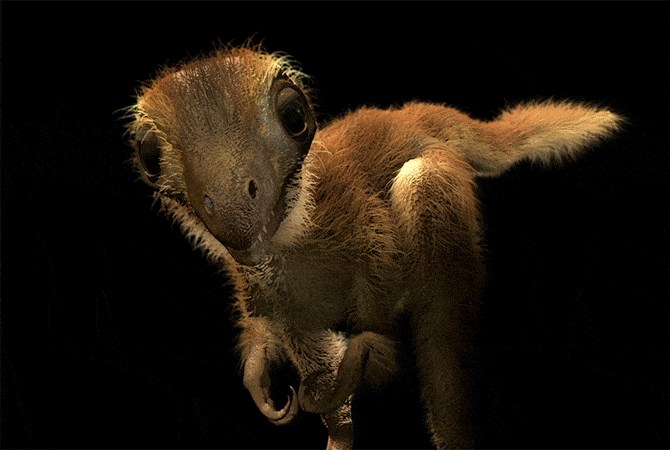
Young Tyrannosaurus individuals might have sported a light coat of feathers, a trait that would have provided insulation and agility. Whether the adults kept their plumage is still up for debate. The 2012 discovery of Yutyrannus huali—a feathered relative from China—suggested that feathers might have been present in even the largest tyrannosaurs. But skin impressions from T. rex specimens later painted a different picture: mostly, if not entirely, scaly. If feathers did exist on the adult tyrant lizard, they were likely sparse—perhaps lost over time or shed to prevent overheating.
Top of the Food Chain
Tyrannosaurus didn’t just live in isolation. It shared its world with a cast of Late Cretaceous contemporaries like Triceratops, Edmontosaurus, Ankylosaurus, Ornithomimus, Pachycephalosaurus, Torosaurus, Alamosaurus, and even the controversial Nanotyrannus, which might have been a juvenile T. rex or its own distinct genus.
In this vibrant ecosystem, Tyrannosaurus reigned supreme. It was the apex predator, a dominant force that hunted actively but wouldn’t turn down an easy scavenging opportunity. It had an impressive arsenal: a powerful sense of smell, hearing tuned to low-frequency vibrations, and—contrary to outdated myths—exceptional eyesight, likely rivaling that of modern birds of prey. Some scientists even suggest it had limited thermal vision, which would have helped it hunt in low light. Although capable of brief bursts of speed up to 15–25 mph (24–40 km/h), it wasn’t built for long chases. Instead, it likely used ambush tactics—possibly even hunting in family packs.
Its massive tail, measuring around 20 feet (6 meters), acted as a counterweight and dynamic rudder, helping it maintain balance and make surprisingly agile turns for its size.
Brains, Brawn, and a Bone-Crushing Bite

The mind of Tyrannosaurus has sparked much curiosity. Some studies suggested it may have been as smart as a baboon—others more recently placed its intelligence closer to that of crocodiles. Whatever the case, this was no lumbering brute. It had a brain wired for survival: keen senses, problem-solving abilities, and coordination.
Those famously tiny arms? While they’ve often been the butt of jokes, they were anything but useless. Heavily muscled and strong, they may have helped in grasping prey, aiding mates during reproduction, or pushing the animal upright after resting.

Tyrannosaurus boasted the most powerful bite of any terrestrial animal ever discovered. Its jaws were built like a hydraulic press, its thick, serrated teeth capable of crunching straight through bone. Fossil evidence suggests Tyrannosaurus was a fast healer too—its injuries, though gruesome, mended rapidly, not unlike modern crocodilians.
It may even have been a cannibal, with fossilized bite marks on other Tyrannosaurus bones hinting at intraspecies combat or scavenging.
A Legacy Written in Bone
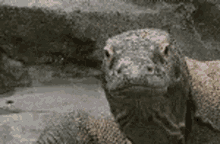
The more we learn, the more impressive Tyrannosaurus becomes. Recent estimates suggest that around 2.5 billion individuals have lived over the species’ existence. A 2023 study revealed it likely had lizard-like lips, more akin to those of modern Komodo dragons, protecting its teeth from the elements. Its vertebrae, which had a hollow, lightweight structure, may have helped it float—suggesting an unexpected aquatic advantage.
Even over a century after its discovery, Tyrannosaurus continues to evolve in the eyes of science—just as powerful, mysterious, and captivating as ever.
Characteristics of InGen’s Tyrannosaurus Rex Clones

InGen’s cloned Tyrannosaurus rex isn’t a perfect mirror of the prehistoric original—it’s a creature crafted by science, with a few biological quirks that set it apart. One of the most famous of these is its peculiar vision. Thanks to the inclusion of frog DNA during the cloning process, these T. rex clones can only perceive movement—meaning if you stay perfectly still, you just might survive an encounter. (At least in theory.)
Like all of InGen’s engineered theropods, their T. rex comes with anatomically inaccurate pronated wrists—palms facing downward like a lizard—something that real theropods couldn’t do. However, this design was slightly tweaked in Jurassic World: Dominion to edge a little closer to scientific accuracy.
Speed-wise, these cloned giants can hit 32 miles per hour, outpacing earlier versions that topped out around 25. It’s a terrifying improvement, especially when you imagine one thundering toward you in full sprint.
Another visual difference lies in their faces. The cloned T. rex bears a permanent, fearsome snarl—even when its mouth is closed, its upper teeth remain exposed. This is in contrast to what scientists now believe about the original animal, which likely had lips that covered its teeth, much like a Komodo dragon.
Tyrannosaurus Rex in the Movies: A Legend on the Silver Screen
Origins in Deep Time
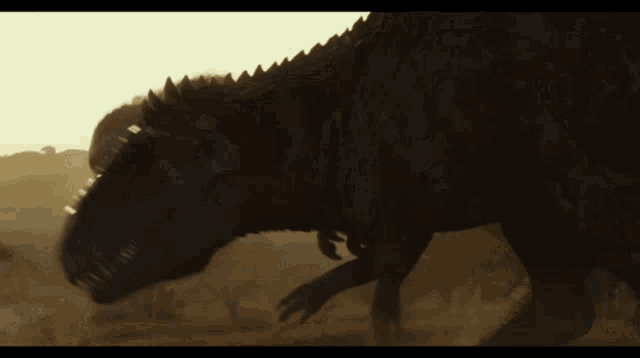
Long before humans walked the Earth, in the dying days of the Cretaceous, a feathered Tyrannosaurus faced off against a rival predator—Giganotosaurus. The battle was brief and brutal. The tyrant lizard king fell... but death was only the beginning. As its blood cooled, a single mosquito landed—feeding on the fallen titan. That blood, preserved in amber, would one day give rise to a legend reborn.
InGen’s Creation
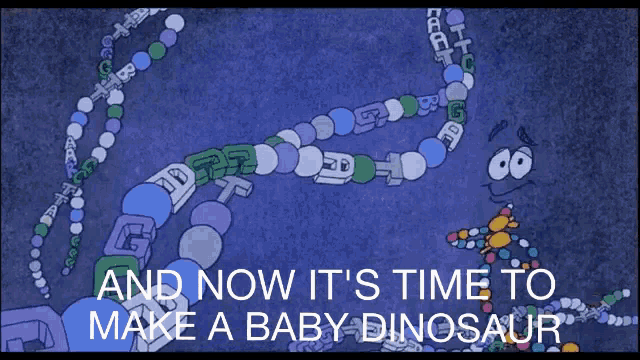
In the early 1990s, InGen scientists, working in secret on Isla Sorna, cloned seven Tyrannosaurus rex individuals. One of them, hatched in 1988, would go on to become the most iconic of them all—living over 25 years and surviving every major catastrophe to come. Fans know her as Rexy.
Jurassic Park (1993)
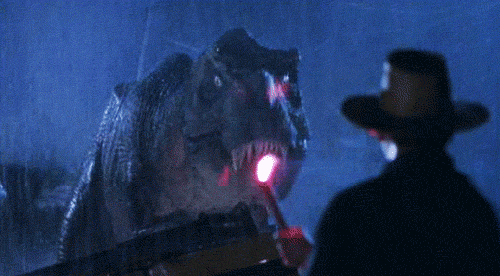
Rexy first roared onto screens in Jurassic Park. At first, she refused to appear for park guests—even when tempted with a goat. But when Dennis Nedry disabled the security systems, Rexy broke free in a legendary scene: devouring Donald Gennaro, attacking a flipped Ford Explorer, and chasing survivors through a stormy night. The next day, she famously ambushed a pack of Velociraptors inside the Visitor Center, saving the protagonists in a moment that defined the franchise. As the banner “When Dinosaurs Ruled the Earth” drifted to the floor, she roared—queen once more.
The Lost World: Jurassic Park (1997)
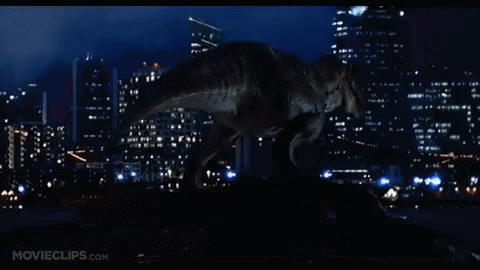
InGen introduced a T. rex family: Buck, Doe, and their infant, Junior. When their child was taken, the parents unleashed chaos on the humans. From destroying Eddie Carr’s vehicle to trampling and devouring members of Roland Tembo’s expedition, the T. rex pair left devastation in their wake. Buck was eventually captured and shipped to San Diego, where he rampaged through the city before Ian Malcolm and Sarah Harding returned him—and Junior—safely to Isla Sorna.
Jurassic Park III (2001)
![Mirko Kosmos — T-Rex vs. Spinosaurus [Jurassic Park III, 2001]](https://64.media.tumblr.com/75b3348d9f0381c0d88354eba216be90/tumblr_nphquv7EAm1qd479ro1_640.gif)
On Isla Sorna, a male T. rex known as The Bull makes a brief but memorable appearance. He confronts the film’s new apex predator, the Spinosaurus, in a fierce showdown. Despite his ferocity, The Bull is overpowered and killed—marking a shocking shift in the franchise's power dynamic.
Jurassic World (2015)
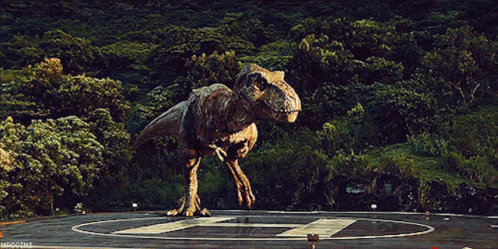
Now a veteran of disaster, Rexy returns in Jurassic World. She’s brought in as a last-ditch effort to stop the genetically engineered Indominus rex. With help from Velociraptor Blue, the two team up to push the hybrid into the Mosasaurus lagoon—where the sea beast finishes the job. Rexy, scarred but triumphant, roars over the ruins of the park, a reminder of nature’s enduring dominance.
Jurassic World: Camp Cretaceous (2020–2022)

Season 2: Rexy stalks the island, killing a Parasaurolophus and terrorizing the campers.
Season 3: She nearly drags down a helicopter in a display of raw strength, only for the Mosasaurus to steal the kill.
Season 4: On Mantah Corp Island, new tyrannosaurs are introduced—Big Eatie and her daughter Little Eatie. They’re studied by Dr. Mae Turner, but unethical experiments nearly destroy their bond. Despite being drugged and forced into battles, they survive.
Season 5 and onward continue the evolution of these characters, showing deeper behaviors and family dynamics among cloned T. rexes.
Jurassic World: Fallen Kingdom (2018)

Amid Mount Sibo’s eruption, Rexy reappears—stopping a Carnotaurus mid-charge and barely escaping the island’s destruction. Later, sedated and used for a blood transfusion to save Blue, she awakens in a truck and nearly kills Owen Grady. At Lockwood Manor, she’s caged and auctioned—until Maisie sets her free. Rexy kills Eli Mills in a final act of poetic justice and crushes the last sample of Indominus DNA beneath her foot, ending the hybrid threat forever. She then breaks into a zoo, roaring at a lion in a face-off of apex predators.
Jurassic World: Chaos Theory (2024)
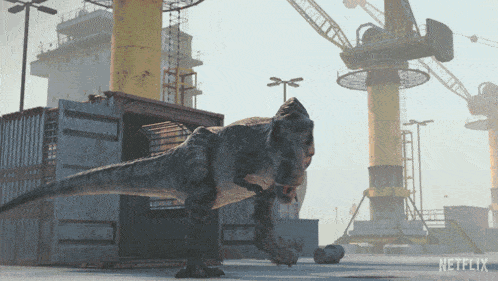
Season 1: Big Eatie is discovered as part of a smuggling operation, spotted by Darius and Kenji at DPW Harbor. She escapes when her container is damaged—reminding everyone why these creatures were never meant to be contained.
Jurassic World: Dominion (2022)

By 2022, Rexy roams the American wilderness, her sightings scattered across California and Oregon. During a misguided DFW chase, she crashes into a drive-in theater—causing chaos but escaping once again. Eventually, she’s captured and relocated to Biosyn’s sanctuary in Italy.
There, she faces off once more with her ancient rival—the Giganotosaurus. This time, she teams up with a Therizinosaurus, and together they bring down the larger predator. The final scenes reunite her with the older Lost World T. rexes, Buck and Doe, closing the chapter on a saga that spanned decades, continents, and generations.
Jurassic World: Rebirth
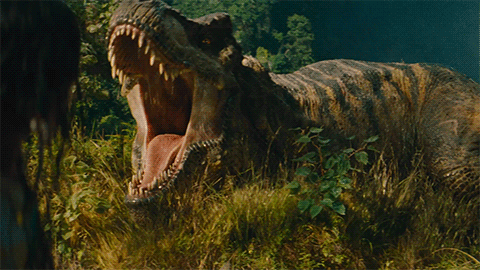
A new era is on the horizon. Jurassic World: Rebirth promises to push the boundaries of genetic power and prehistoric terror. This time, we won’t just revisit the dinosaurs we know—we’ll encounter evolved variants, modified by science in ways we’ve never seen. Among them? A radically reimagined version of Rexy herself. Altered. Enhanced. Unpredictable.
The legacy of the Tyrannosaurus is about to mutate.
Tyrannosaurus in the Novels
While the films brought Tyrannosaurus rex to global fame, the novels and extended lore offered deeper, sometimes surprising insights into the species.
Jurassic Park Institute Glossary Entries
Within the official Jurassic Park Institute glossary—an educational and fan resource created to expand the franchise's world—there are several notable entries tied to the tyrant king of dinosaurs.
-
Tyrannosaurus rex is, of course, prominently featured. As the franchise’s most iconic predator, it stands front and center in both fiction and scientific discussions.
-
Also listed is Tyrannosaurus bataar, now recognized by paleontologists as Tarbosaurus, a close Asian relative of T. rex. Its inclusion nods to the broader tyrannosaur family and their evolutionary diversity.
-
Lastly, there's a curious entry for Dinotyrannus—a name once proposed for a separate genus, but now considered synonymous with Tyrannosaurus rex. This reflects real-world paleontological debates mirrored in the franchise's lore.
These entries showcase how T. rex has remained not only a cinematic icon, but a subject of ongoing fascination in both fictional and scientific worlds.
Subscribe
Sign up to get the latest on sales, new releases and more …
